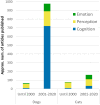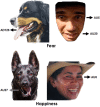Visual perception of emotion cues in dogs: a critical review of methodologies
- PMID: 36870003
- PMCID: PMC10066124
- DOI: 10.1007/s10071-023-01762-5
Visual perception of emotion cues in dogs: a critical review of methodologies
Abstract
Comparative studies of human-dog cognition have grown exponentially since the 2000's, but the focus on how dogs look at us (as well as other dogs) as social partners is a more recent phenomenon despite its importance to human-dog interactions. Here, we briefly summarise the current state of research in visual perception of emotion cues in dogs and why this area is important; we then critically review its most commonly used methods, by discussing conceptual and methodological challenges and associated limitations in depth; finally, we suggest some possible solutions and recommend best practice for future research. Typically, most studies in this field have concentrated on facial emotional cues, with full body information rarely considered. There are many challenges in the way studies are conceptually designed (e.g., use of non-naturalistic stimuli) and the way researchers incorporate biases (e.g., anthropomorphism) into experimental designs, which may lead to problematic conclusions. However, technological and scientific advances offer the opportunity to gather much more valid, objective, and systematic data in this rapidly expanding field of study. Solving conceptual and methodological challenges in the field of emotion perception research in dogs will not only be beneficial in improving research in dog-human interactions, but also within the comparative psychology area, in which dogs are an important model species to study evolutionary processes.
Keywords: Bodily expressions; Emotion cues; Facial expressions; Human–dog relationship; Methodology; Visual perception.
© 2023. The Author(s).
Conflict of interest statement
All authors declare that they have no competing interests.
Figures






Similar articles
-
Bodily emotional expressions are a primary source of information for dogs, but not for humans.Anim Cogn. 2021 Mar;24(2):267-279. doi: 10.1007/s10071-021-01471-x. Epub 2021 Jan 28. Anim Cogn. 2021. PMID: 33507407 Free PMC article.
-
Perception of dynamic facial expressions of emotion between dogs and humans.Anim Cogn. 2020 May;23(3):465-476. doi: 10.1007/s10071-020-01348-5. Epub 2020 Feb 12. Anim Cogn. 2020. PMID: 32052285 Free PMC article.
-
How do children view and categorise human and dog facial expressions?Dev Sci. 2023 May;26(3):e13332. doi: 10.1111/desc.13332. Epub 2022 Oct 17. Dev Sci. 2023. PMID: 36205172
-
Dogs functionally respond to and use emotional information from human expressions.Evol Hum Sci. 2022 Dec 6;5:e2. doi: 10.1017/ehs.2022.57. eCollection 2023. Evol Hum Sci. 2022. PMID: 37587944 Free PMC article. Review.
-
Mapping the Passions: Toward a High-Dimensional Taxonomy of Emotional Experience and Expression.Psychol Sci Public Interest. 2019 Jul;20(1):69-90. doi: 10.1177/1529100619850176. Psychol Sci Public Interest. 2019. PMID: 31313637 Free PMC article. Review.
Cited by
-
Village dogs match pet dogs in reading human facial expressions.PeerJ. 2023 Jul 6;11:e15601. doi: 10.7717/peerj.15601. eCollection 2023. PeerJ. 2023. PMID: 37431468 Free PMC article.
References
Publication types
MeSH terms
LinkOut - more resources
Full Text Sources

